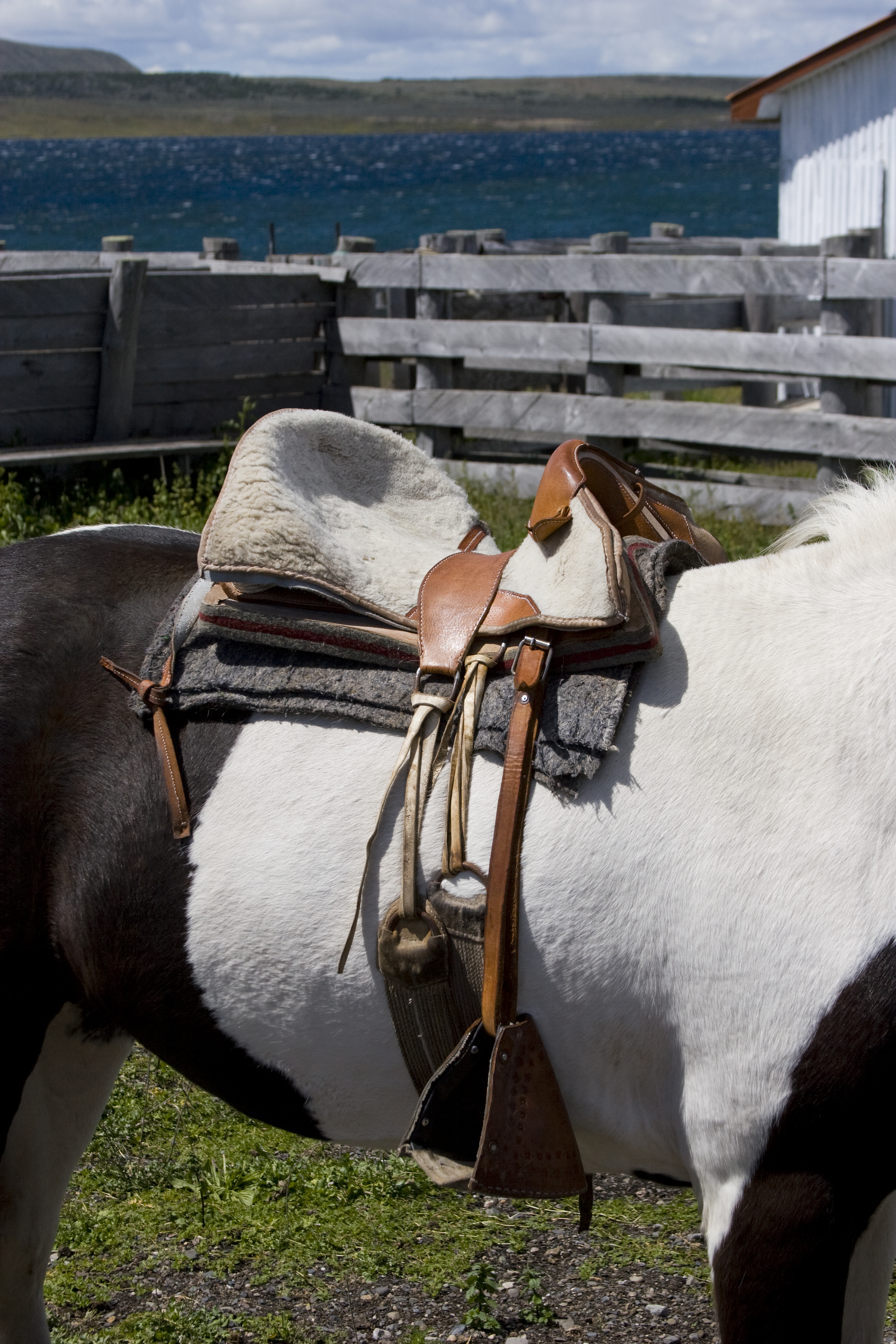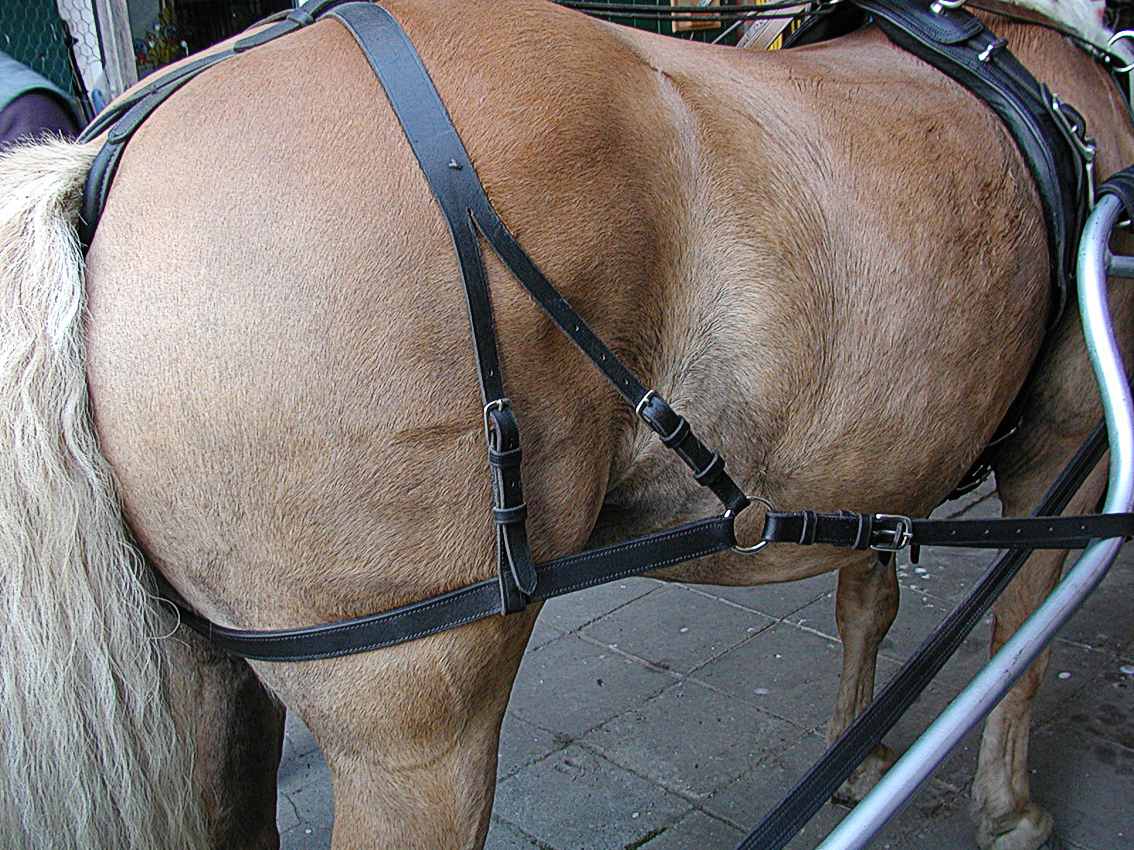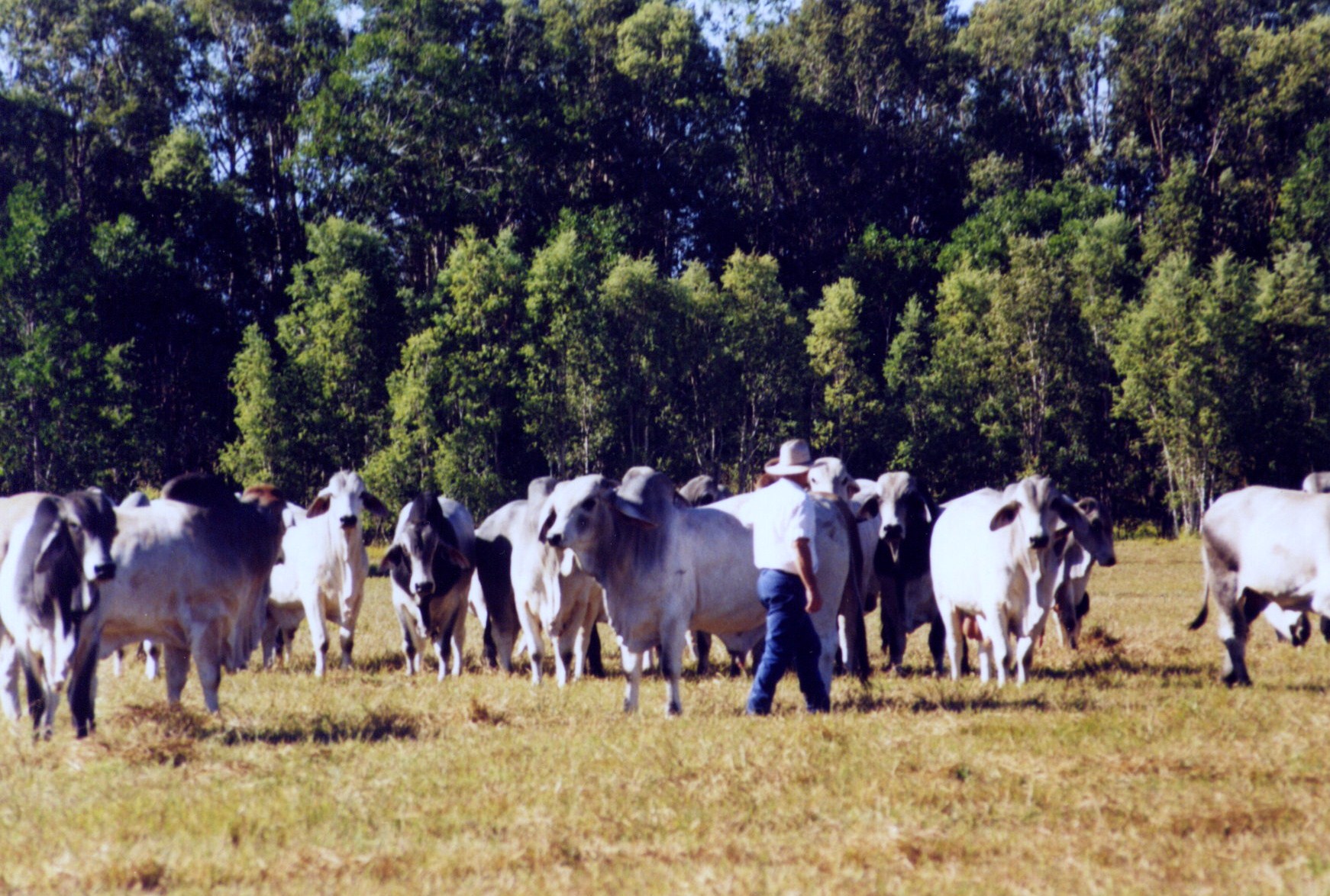|
Girth (tack)
A girth, sometimes called a cinch (Western riding), is a piece of equipment used to keep the saddle in place on a horse or other animal. It passes under the barrel of the equine, usually attached to the saddle on both sides by two or three leather straps called billets. Girths are used on Australian and English saddles, while western saddles and many pack saddles have a cinch, which is fastened to the saddle by a single wide leather strap on each side, called a latigo. Retrieved on 17 March 2009 Although a girth is often enough to keep a well-fitting saddle in place, other pieces of equipment are also used in jumping or speed sports such as , |
Breeching (horse)
Breeching ( "britching") is a strap around the haunches of a draft, pack or riding animal. Both under saddle and in harness, breeching engages when an animal slows down or travels downhill and is used to brake or stabilize a load. History The breeching strap traces its roots back to the Chinese invented breast-strap or "breastcollar" harness developed during the Warring States (481–221 BC) era.Needham, Volume 4, Part 2, 28. The Chinese breast harness became known throughout Central Asia by the 7th century,Needham, Volume 4, Part 2, 311–315. introduced to Europe by the 8th century. The breeching strap would allow the horse to hold or brake the load as horse harnesses were previously attached to vehicles by straps around their necks as previously designed harnesses would constrict the horses neck preventing the horse from pulling heavier loads. The breeching strap acted as a brake when a cart tries to run forward when moving downwards on a slope and also make it possible to ma ... [...More Info...] [...Related Items...] OR: [Wikipedia] [Google] [Baidu] |
Saddle Sores
A saddle sore in humans is a skin ailment on the buttocks due to, or exacerbated by, horse riding or cycling on a bicycle saddle. It often develops in three stages: skin abrasion, folliculitis (which looks like a small, reddish acne), and finally abscess. Because it most commonly starts with skin abrasion, it is desirable to reduce the factors which lead to skin abrasion. Some of these factors include: * Reducing the friction. In equestrian activities, friction is reduced with a proper riding position and using properly fitting clothing and equipment. In cycling, friction from bobbing or swinging motion while pedaling is reduced by setting the appropriate saddle height. Angle and fore/aft position can also play a role, and different cyclists have different needs and preferences in relation to this. * Selecting an appropriate size and design of horse riding saddle or bicycle saddle. * Wearing proper clothing. In bicycling, this includes cycling shorts, with chamois padding. F ... [...More Info...] [...Related Items...] OR: [Wikipedia] [Google] [Baidu] |
Saddle
The saddle is a supportive structure for a rider of an animal, fastened to an animal's back by a girth. The most common type is equestrian. However, specialized saddles have been created for oxen, camels and other animals. It is not known precisely when riders first began to use some sort of padding or protection, but a blanket attached by some form of surcingle or girth was probably the first "saddle", followed later by more elaborate padded designs. The solid saddle tree was a later invention, and though early stirrup designs predated the invention of the solid tree, the paired stirrup, which attached to the tree, was the last element of the saddle to reach the basic form that is still used today. Today, modern saddles come in a wide variety of styles, each designed for a specific equestrianism discipline, and require careful fit to both the rider and the horse. Proper saddle care can extend the useful life of a saddle, often for decades. The saddle was a crucial step ... [...More Info...] [...Related Items...] OR: [Wikipedia] [Google] [Baidu] |
Neoprene
Neoprene (also polychloroprene) is a family of synthetic rubbers that are produced by polymerization of chloroprene.Werner Obrecht, Jean-Pierre Lambert, Michael Happ, Christiane Oppenheimer-Stix, John Dunn and Ralf Krüger "Rubber, 4. Emulsion Rubbers" in Ullmann's Encyclopedia of Industrial Chemistry, 2012, Wiley-VCH, Weinheim. Neoprene exhibits good chemical stability and maintains flexibility over a wide temperature range. Neoprene is sold either as solid rubber or in latex form and is used in a wide variety of commercial applications, such as laptop sleeves, orthopaedic braces (wrist, knee, etc.), electrical insulation, liquid and sheet-applied elastomeric membranes or flashings, and automotive fan belts. Production Neoprene is produced by free-radical polymerization of chloroprene. In commercial production, this polymer is prepared by free radical emulsion polymerization. Polymerization is initiated using potassium persulfate. Bifunctional nucleophiles, metal oxides ( ... [...More Info...] [...Related Items...] OR: [Wikipedia] [Google] [Baidu] |
Mohair
Mohair (pronounced ) is a fabric or yarn made from the hair of the Angora goat. (This should not be confused with Angora wool, which is made from the fur of the Angora rabbit.) Both durable and resilient, mohair is notable for its high luster and sheen, and is often used in fiber blends to add these qualities to a textile. Mohair takes dye exceptionally well. It feels warm in winter as it has excellent insulating properties, while its moisture-wicking properties allow it to remain cool in summer. It is durable, naturally elastic, flame-resistant and crease-resistant. It is considered a luxury fiber, like cashmere, angora, and silk, and can be more expensive than most sheep's wool. Mohair is composed mostly of keratin, a protein found in the hair, wool, horns and skin of all mammals, but mohair's special properties are unique to the Angora goat. While it has scales like wool, the scales are not fully developed, merely indicated. Thus, mohair does not feel the same way common o ... [...More Info...] [...Related Items...] OR: [Wikipedia] [Google] [Baidu] |
Horseshoe Stud
A caulkin (or ''caulk''; US spelling "calkin" or "calk") from the Latin ''calx'' (the heel) is a blunt projection on a horseshoe or oxshoe that is often forged, welded or brazed onto the shoe."Know Foot Know Horse", knowfootknowhorse.com, 2008, webpageKnowFKH-20"Farrier Competition Results 2008", Forge and Farrier, UK, 2008, webpage/ref> The term may also refer to traction devices screwed into the bottom of a horseshoe, also commonly called shoe studs or screw-in calks. These are usually a blunt spiked cleat, usually placed at the sides of the shoe. Use Caulkins or studs improve a horse's balance and grip over uneven or slippery terrain, allowing the animal to move better and jump more confidently in poor footing. Screw in calks are most often seen in speed sports, such as eventing, polo, and show jumping, although they are sometimes used for dressage. Forged caulks of various styles are more often seen on race horses and working animals such as draft horses and some pack ... [...More Info...] [...Related Items...] OR: [Wikipedia] [Google] [Baidu] |
Eventer
Eventing (also known as three day eventing or horse trials) is an equestrian event where a single horse and rider combine and compete against other competitors across the three disciplines of dressage, cross-country, and show jumping. This event has its roots in a comprehensive cavalry test that required mastery of several types of riding. The competition may be run as a one-day event (ODE), where all three events are completed in one day (dressage, followed by show jumping and then the cross-country phase) or a three-day event (3DE), which is more commonly now run over four days, with dressage on the first two days, followed by cross-country the next day and then show jumping in reverse order on the final day. Eventing was previously known as Combined Training, and the name persists in many smaller organizations. The term "Combined Training" is sometimes confused with the term "Combined Test", which refers to a combination of just two of the phases, most commonly dressage an ... [...More Info...] [...Related Items...] OR: [Wikipedia] [Google] [Baidu] |
Steeplechase (horse Racing)
A steeplechase is a distance horse race in which competitors are required to jump diverse fence and ditch obstacles. Steeplechasing is primarily conducted in Ireland (where it originated), the United Kingdom, Canada, United States, Australia, and France. The name is derived from early races in which orientation of the course was by reference to a church steeple, jumping fences and ditches and generally traversing the many intervening obstacles in the countryside. Modern usage of the term "steeplechase" differs between countries. In Ireland and the United Kingdom, it refers only to races run over large, fixed obstacles, in contrast to " hurdle" races where the obstacles are much smaller. The collective term "jump racing" or " National Hunt racing" is used when referring to steeplechases and hurdle races collectively (although, properly speaking, National Hunt racing also includes some flat races). Elsewhere in the world, "steeplechase" is used to refer to any race that involve ... [...More Info...] [...Related Items...] OR: [Wikipedia] [Google] [Baidu] |
Flat Racing
Horse racing is an equestrian performance sport, typically involving two or more horses ridden by jockeys (or sometimes driven without riders) over a set distance for competition. It is one of the most ancient of all sports, as its basic premise – to identify which of two or more horses is the fastest over a set course or distance – has been mostly unchanged since at least classical antiquity. Horse races vary widely in format, and many countries have developed their own particular traditions around the sport. Variations include restricting races to particular breeds, running over obstacles, running over different distances, running on different track surfaces, and running in different gaits. In some races, horses are assigned different weights to carry to reflect differences in ability, a process known as handicapping. While horses are sometimes raced purely for sport, a major part of horse racing's interest and economic importance is in the gambling associated with ... [...More Info...] [...Related Items...] OR: [Wikipedia] [Google] [Baidu] |
Stockman (Australia)
In Australia a stockman (plural stockmen) is a person who looks after the livestock on a large property known as a station, which is owned by a grazier or a grazing company, traditionally on horseback. In this sense it has a similar meaning to "cowboy". A stockman may also be employed at an abattoir, feedlot, on a livestock export ship, or with a stock and station agency. Associated terms Stockmen who work with the cattle in the Top End are known as ringers and are often only employed for the dry season which lasts from April to October. A station hand is an employee who is involved in routine duties on a rural property or station, which may also involve caring for livestock. With pastoral properties facing dire recruitment problems as young men are lured into the booming mining industry, young women from the cities are becoming a common sight on outback stations, often attracted by the chance to work with horses. An associated occupation is that of the drover, who, like ... [...More Info...] [...Related Items...] OR: [Wikipedia] [Google] [Baidu] |







